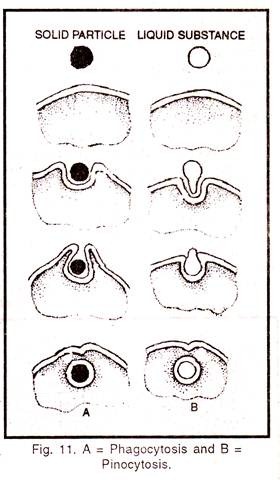ADVERTISEMENTS:
In this article we will discuss about:- 1. Meaning of Plasma Membrane 2. Chemical Composition of Plasma Membrane 3. Origin 4. Functions.
Meaning of Plasma Membrane:
The term ‘Plasma membrane’ was given by Pfeffer. It is situated just inside the cell wall and is also termed as cell membrane, plasma lemma or cytomembrane. The term ‘Plasma lemma’ was given by Plower (1931). Nageli and Cramer (1855) used the term ‘Cell membrane’.
Overton (1902) was the first man who studied the structure of plasma membrane and stated that it is composed of a thin layer of lipid. Gorter and Grandell (1935) suggested that plasma membrane is made up of double layer of lipid molecules. Robertson (1961) gave a “unit membrane concept”. According to which all the membranes of the cell were constructed of protein-lipid-protein. Singer and Nicholson (1972) proposed “Fluid Mosaic Model”.
ADVERTISEMENTS:
According to which lipid and integral proteins are present in a mosaic arrangement and the biological membranes are semifluid so that the lipids as well as integral proteins are able to make movement within the bilayer.
The cytoplasm is bounded on the outer side by a delicate, flexible, thin layer called the plasma lemma or ectoplast. It is 75-100 Å thick. Likewise to the inner side it is bounded by another membrane said as tonoplast which is 75-100 Å thick. The main function of cell membrane is to regulate the transfer of materials inside and outside of the cell.
It acts as selectively or differentially permeable membrane. It prevents the entrance of toxic elements into the cytoplasm and provides only a one-way passage for materials like minerals into the cell and checks their outward movement. In the above process, the substances enter cell by first being absorbed on the plasma membrane and then being transmitted inside the cell.
Chemical Composition of Plasma Membrane:
ADVERTISEMENTS:
The plasma membrane is composed of mainly proteins (60-80%) and lipids (20-40%) and a small percentage of carbohydrate, (1-5%). Proteins are the main components of plasma membrane since they provide mechanical support and act as channels for different vital or physiological activities.
Very recently Bell (1962) has suggested the presence of polysaccharides in the outer layer of plasma membrane and this saccharide gives the stability to the lipoprotein complex. Besides, some thirty enzymes have been isolated from different plasma membrane. Among them, most important are 5-nucleotides, phosphomonesterase, adenyl cyclase, Na+ —K+ activated ATPase, alkaline phosphatase.
Origin of Plasma Membrane:
The actual mechanism of its origin is till obscure or not clear. Some one tell that membrane is an independent organelle which enlarges with growth naturally. Others regard due to the deposition of surface active substances at the phase boundary. That is, it originates by self accumulation of its component chemical molecules.
Functions of Plasma Membrane:
In general, plasma membrane has a variety of functions to perform. It delimits the protoplasm from the environment and escapes from adverse calamities. It controls cellular semi-permeability, excretion, secretion and represents a selective pathway for transport of substance into and outside the cell controlling cell activity and form.
The inflow of materials into cytoplasm through plasma membrane occurs mainly by osmosis, pinocytosis, phagocytosis and active transport.
1. Osmosis:
The diffusion of water molecules or low concentrated solvent to higher concentrated solvent through a semi-permeable membrane is said as osmosis. Plasma membrane acts as a semi-permeable membrane allowing the movement of water molecules in and out.
The permeability of the most of the substances specially non-electrolytes is directly proportional to their lipid solubility. The process in which the water molecules enter the cell is known as Endosmosis and the outward flow of water molecules from the cell is known as Exosmosis.
2. Pinocytosis and phagocytosis:
ADVERTISEMENTS:
The ingestion of solid particles by a cell through plasma membrane is called as phagocytosis while in pinocytosis, discovered by Lewis (1931), the liquid substances are incorporated into the cell by plasma membrane. Phagocytosis is a Greek word which means to ‘eat’. This process is common in large number of protozoans and among certain cells of the Metazoa.
The particles become absorbed at the surface membrane and later on they are taken in to the cytoplasm by in-folding of plasma membrane. The particles thus ingested form vacuoles known as phagosomes which are digested by lysosome activity in the cell.
3. Active and passive transport:
ADVERTISEMENTS:
The molecules of different substances are transported across the membrane either by passive or by active transport. In passive transport, movement of molecules or ions are from low to high concentration. In the process energy is required. The energy comes from ATP produced by oxidative phosphorylation.
The active transport of the molecules through plasma membrane is directly related to cell respiration. Giese (1971) called the active transport as metabolically linked transport. Active transport is very important as it helps in maintaining a definite ionic concentration and a definite osmotic pressure within the living system.
The actual mechanism of active transport is still not clear. Several theories have been given to explain this phenomenon which are as follows— (a) According to Carrier’s hypothesis, a carrier molecule which is a component of plasma membrane picks up the transportant and forms the carrier transport complex with it. The carrier may be an enzyme, lipid or protein.
Several enzymes also participate in this active transport system. It was well supported by Anderson, Ussing and Stein (1960). The fluid mosaic model of plasma membrane explains the transport of molecules or ions through the plasma membrane. The lipid bilayer allows the movements of molecules of lipids and proteins. The lipid bilayer also allows the movement of carrier transport complex.
